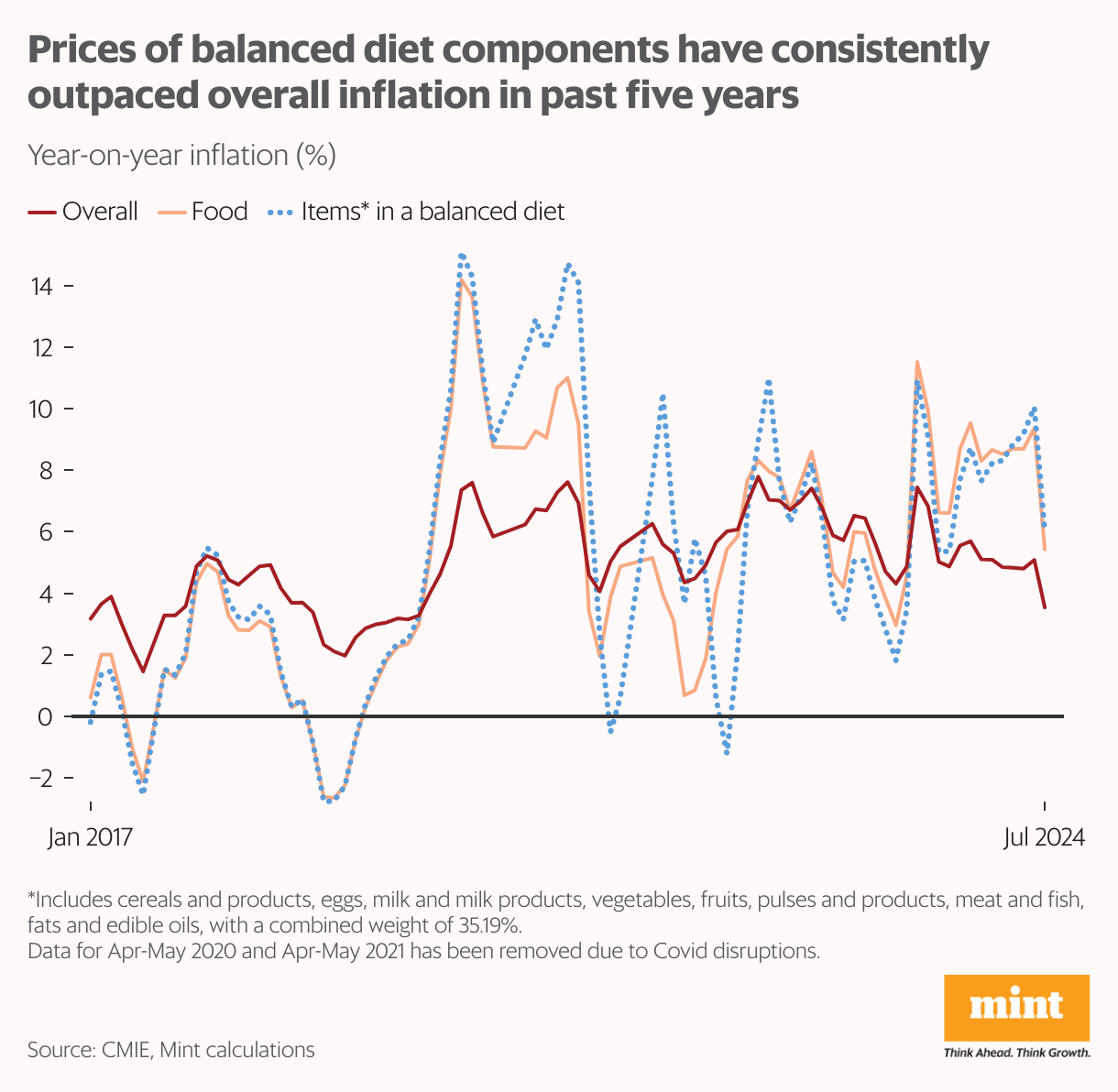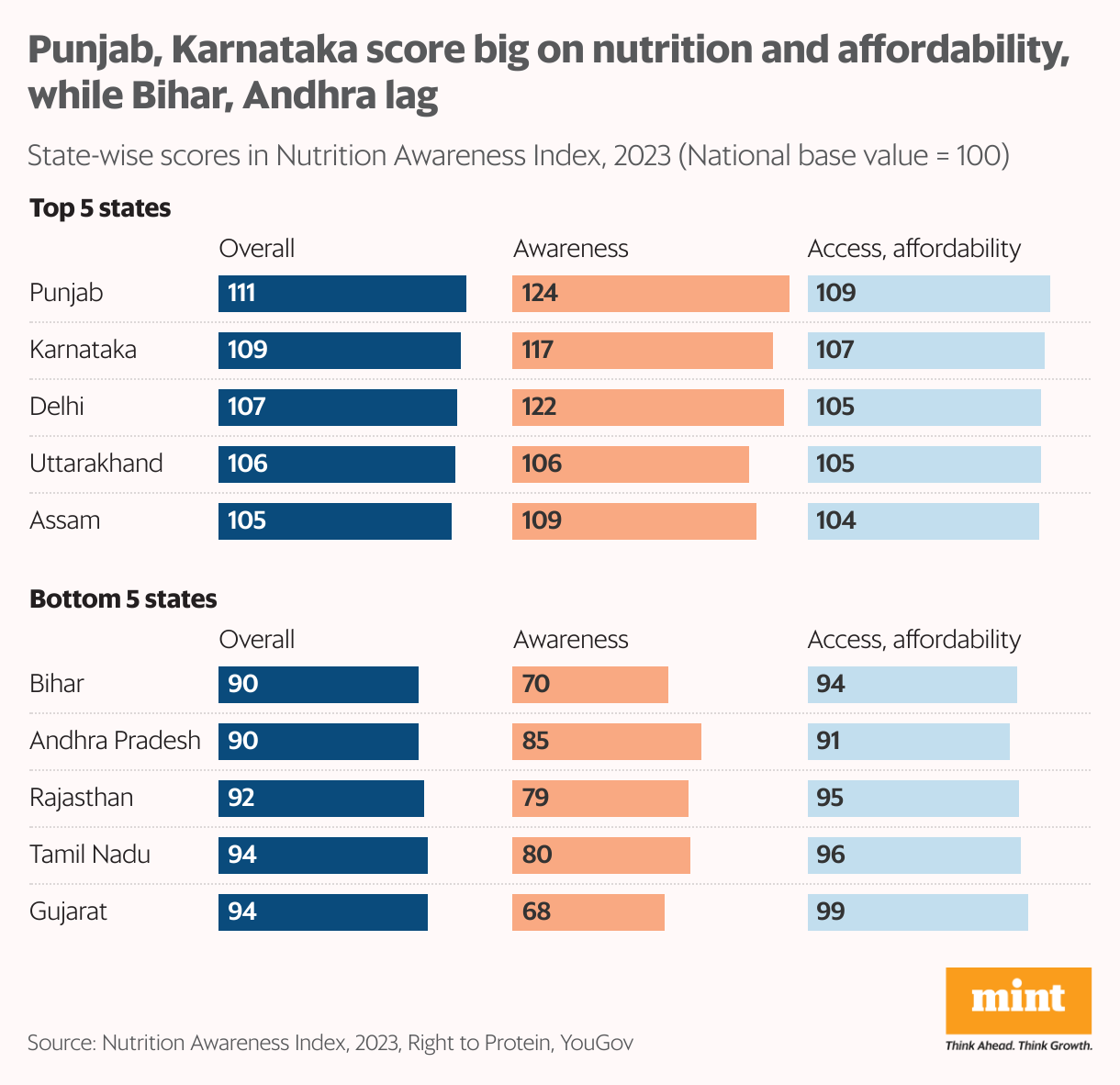Our Terms & Conditions | Our Privacy Policy
Diet dilemma: Why India struggles to eat right
Dietary patterns of Indians reveal significant gaps in meeting nutritional guidelines. “My Plate for the Day”, a nutritional guide developed by the Indian Council for Medical Research (ICMR) and the National Institute for Nutrition (NIN), recommends that half of a person’s daily plate should be filled with vegetables and fruits, and the other half with cereals, millets, pulses, flesh foods, eggs, nuts, oilseeds, and milk or curd. But Indians tend to under-consume micronutrient-rich foods, such as whole grains, pulses, and fresh produce, and over-consume refined cereals, data shows.
The guide says that one should not depend on cereals for more than 45% of the total daily energy needs; the rest should come from less carbohydrate-heavy nutrients. But the ICMR-NIN study noted that cereals actually contribute 50-70% of the daily energy requirement of Indians, whereas pulses, meat, poultry, and fish together provide only 6-9%, well below the recommended 14%.
The reliance on cereals may have declined over the past decade, data from the government’s consumption survey shows. Citing the study, a recent report by the Economic Advisory Council to the Prime Minister observed that cereals’ share in household expenditure had declined from 10.7% in 2011-12 to 4.9% in 2022–23 (note that the two years’ data is not strictly comparable).
The report noted that the free foodgrain scheme had potentially helped families save money on cereals and divert some of it towards more nutritious items like fresh fruits, milk and milk products, eggs, and fish and meat.
Also read: Fewer Indians are going hungry. But are they eating healthy?
However, the impact of household economics on nutrition equality is real. The consumption of more nutritious items is significantly lower for the bottom 20% of the population compared to the top 20% (quintiles are based on monthly per capita spending). The inequality is much narrower in the case for cereals.
In rural India, for every 1 kg of cereal that a person in the top 20% eats, a person in the bottom 20% consumes 890 grams. But for every 1 kg of fresh fruits, vegetables, milk and milk products, eggs, fish and meat, and vegetables consumed by the top quintile, the consumption by the bottom quintile is just 360-620 grams. The trend is similar in urban areas.

Outside the budget
A key factor behind the lack of a balanced diet is the escalating cost of food items. In the past five years, elevated food prices have been a major cause of concern (although there were some seasonal corrections). With food prices high, the cost of a balanced diet also increased. The gap between the inflation of major items in a balanced diet and overall inflation has been huge.

Also read: In charts: Volatile vegetables are making inflation bitter
A Mint analysis of major constituents of a balanced diet in the Consumer Price Index (CPI) basket shows that inflation for those items was more than twice the rate of overall inflation in the past year. A report by Respirer Living Sciences, which tracked the cost of maintaining a balanced diet as recommended by ICMR, showed a steep rise in prices in most parts of the country. In some states, a balanced diet has become costlier by over 30% compared to 2019, the study found. “Price rise is not allowing people to have a proper balanced diet; it is almost a luxury,” said Dr Arun Gupta, convenor at the Nutrition Advocacy in Public Interest (NAPi).

Awareness issues
India’s dependence on cereals and the high cost of protein-rich food items are not the only reasons behind the problem. Lack of awareness about healthy eating and aggressive marketing of unhealthy food are other aspects. A Nutrition Awareness Index created by advocacy group Right to Protein and survey agency YouGov, shows that some of the states that are usually considered more prosperous, like Tamil Nadu and Gujarat, lag behind the national average due to a lack of awareness, even though they fare highly on accessibility and affordability.

Furthermore, ICMR highlights that the increased consumption of ultra-processed foods high in sugars, salt and fats, combined with a more sedentary lifestyle, has exacerbated micronutrient deficiencies and obesity rates. Several reports suggest unhealthy processed foods have become more affordable and are being consumed at a high rate. The 2022-23 Household Consumption Expenditure Survey showed that rural Indians spent 9.6% of their average monthly budgets on beverages and processed food, while urban Indians spent 10.6%. This was higher than any other food group. Additionally, the ICMR report says aggressive marketing and promotion by makers of such foods have significantly influenced dietary preferences, steering people towards less nutritious choices.
Previous analyses in Plain Facts have shown high content of sugar, sodium and saturated fats in commonly available food and beverages, even as a proposed star rating system to warn consumers of such content remains in limbo.
Gupta also argued that affordability was not always the barrier to consuming a healthy meal. “If I am swamped by marketing, I will consume that product daily,” he said.
Images are for reference only.Images and contents gathered automatic from google or 3rd party sources.All rights on the images and contents are with their legal original owners.



Comments are closed.